- The 13 Best Semrush Alternatives and Competitors [2025] - March 14, 2023
- The 16+ Best AI Content Generators for Every Business Need [2025] - March 14, 2023
- How to Write a Content Brief [2025] - February 14, 2023
Ended soon
On-page SEO is one of the two pillars of a comprehensive SEO strategy.
On-page SEO, also called “on-site SEO,” is the practice of optimizing the content and structure “on” your site. This work includes:
- Creating content
- Creating a logical navigation structure for your site
- And tackling technical issues that may be hurting your search rankings
Whereas, off-page SEO is everything you do to optimize your site via backlinks, citation building, and other activities “off” your site.
Novice digital marketers tend to be more familiar with the elements of on-page SEO.
But I fancy myself an expert.
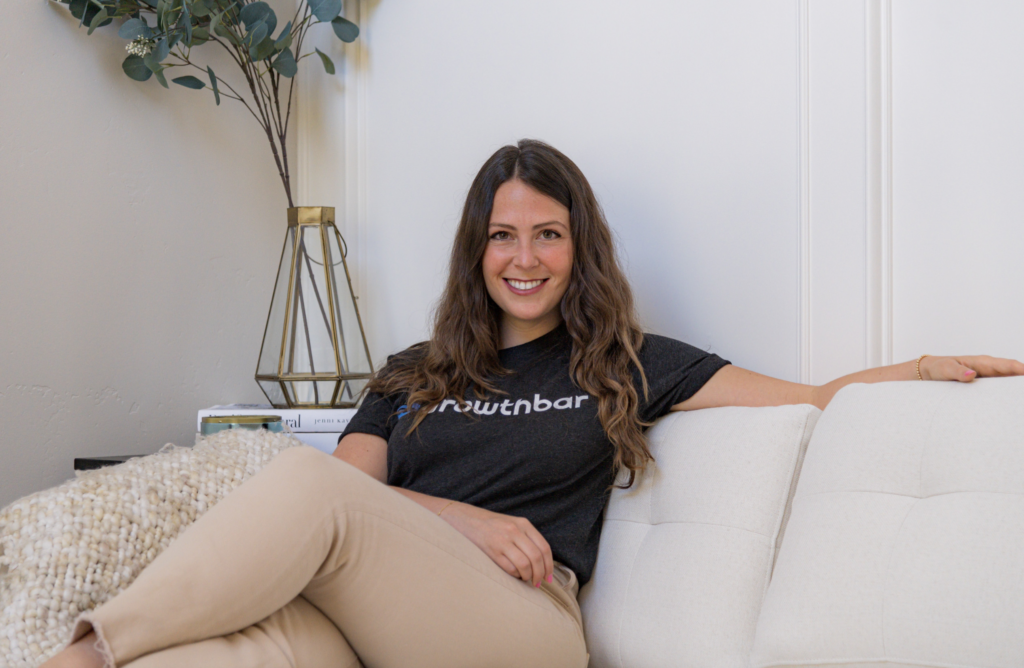
After a decade of leading marketing for technology companies in San Francisco, I started a tool squarely for on-page SEO.
You could say I’m obsessed.
In this guide you’ll learn:
- On-page SEO myths to avoid
- How to create SEO-friendly content to optimize on-page SEO scores
- The best tips to write irresistible titles and descriptions
- The only technical SEO tips you need to know
- and lots more from my personal experience with on-page SEO
Also, check out my business partner, Mark’s video on on-page SEO. He covers most of the same topics as in the post… and then some.
Table of Contents
What is on-page SEO?
Like I said, on-page SEO refers to anything that happens on your site in the name of SEO. On-page SEO includes:
- Internal linkbuilding
- Website structure and UX
- Web page content
- Blog posts and other forms of long-form content
- Title tags, meta descriptions, and other on-page HTML elements
- URLs
- Images
- and more
Also read: Does UI/UX Matter for SEO?
Why on-page SEO is important
On-page SEO practices still matter today, because Google regularly updates its algorithms, enhancing its ability to evaluate and understand both user intent and user experience.
Google is a machine that tries to understand how humans see your website.
So you need to know on-site SEO best practices to increase your search traffic. Well-optimized pages and posts help Google to better understand what your site is about, which helps it to organize and rank your content. You’re helping Google to better do its job.
Google states: “The most basic signal that information is relevant is when a web page contains the same keywords as your search query. If those keywords appear on the page, or if they appear in the headings or body of the text, the information is more likely to be relevant.”
Keywords are the most basic signal to Google. But there are many, many more that I’ll get into soon.
Part 1: On-page SEO myths
Let’s talk about common advice you might see on on-page SEO best practices that just aren’t true today.
I want to start with these because I don’t want you to waste your time.
While they are many old-school practices that are still being recommended, I want to focus on just three (3) of them to help you navigate the noise and scale your search traffic. Avoid these mistakes so that you can rank your content higher in SERPs.
1. Stuffing exact match keywords
Firstly, on-page SEO is not about stuffing exact match keywords. It used to be a common practice to include the exact keyword you want to rank for in your title, URL, and content.
For instance, if you wanted to rank for the keyword “Car Dealer San Francisco”, you’d stuff that keyword throughout your page or content even when it didn’t make sense grammatically.
Google is smart enough to understand things like connecting words, synonyms, and closely related words and phrases. For all of these 3 queries, the top ten pages are nearly identical.
“Knife steel types”
“Types of steel knives”
“Types of knife metal”
Unfortunately, stuffing exact match keywords is still being practiced today which can lead to poor user experience and poor readability — all things that on-page SEO should not be.
Pro Tip: Use related queries, similar phrases, and closely related words throughout your content (so-called LSI keywords). This offers you the chance to rank for other queries of your target keyword.
2. Using keywords specific number of times
On-page SEO is also not about using your keyword a specific number of times on your page or content.
In Ahref’s study of 3 million search queries, they found that on average the top ranking page also ranks for around 1,000 other relevant keywords in the top 10.
You can imagine what it will be like if the top ranking page had to mention all one thousand of those keywords at least three (3) times, it makes your work more tedious.
Instead, include your target keyword in your content when it makes sense. Adding your target keyword to your content should come naturally.
3. Meeting word count
On-page SEO is not about meeting a minimum word count. Our GrowthBar study, showed that there is correlation between length and ranking — but it’s usually not completely statistically significant.
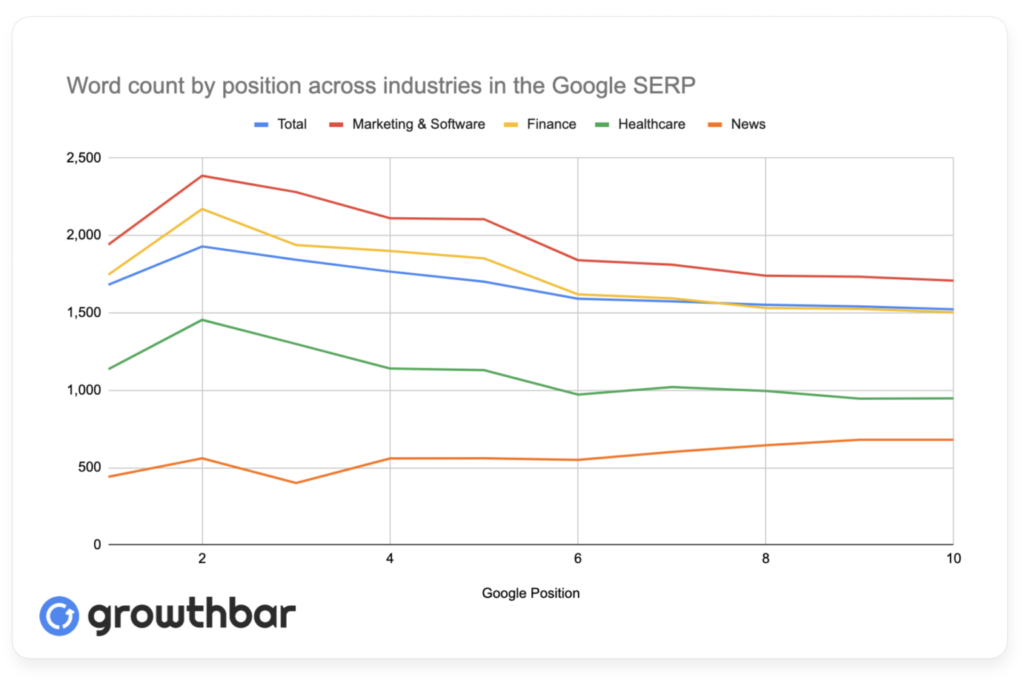
Check out this example: Ahrefs backlink checker has around 941 words yet they rank number one for their target keyword and the page generates around 50,000 visitors from Google search alone.
Also read: How Long Does a Blog Post Need to Be? (Backed by Thousands of Data Points)
Part 2: Plan your SEO content
Content is the backbone of SEO.
Every result you click in the Google SERP is content — whether video, blog post, e-commerce page, or otherwise. While this is probably obvious, you’ll need to plan your content before creating and optimizing it.
These are the three things to do before creating your content:
- Satisfy search intent
- Learn from your competitors
- Perform a content gap analysis
1. Satisfy search intent
Search Intent (user intent) is the main goal a user has when typing a query into a search engine. Common types of search intent include informational, commercial, navigational, and transactional. In simple terms, satisfying search intent is ultimately Google’s number one goal.
So for you to succeed with SEO and content marketing, search intent needs to be a part of your strategy.
Backlinks, great content, and other traditional Google ranking signals are great. But if your page doesn’t satisfy search intent, it’s not going to rank.
The good news is that it’s super easy to understand the search intent for a given query. Simply browse in an incognito tab or use a tool like GrowthBar to see which articles rank at the top of the Google SERP for a given query.
As you analyze their content, take note of the following:
- The format of the content: is it a webpage, a long-form blog post, an ebook, a video, or something else?
- Elements they use: title, headings, subheadings, bullets, links, etc. they use
- Content angle: is the content newsworthy, is it informative, is it opinion, or is it some blend?
2. Learn from your competitors
Expanding on search intent: you should also take a look at your competitors in the SERP.
The top-ranking pages are ranking at the top for a reason. Google and other search engines deem them as the best candidates to satisfy a searcher’s query.
So they’re doing something right, at least from the perspective of a search engine.
Try and understand what exactly they’re doing.
While the content will vary from topic to topic, the way you research your competitors’ content will be more or less the same. In many cases, the majority of pages are blog posts with some in the listicle format and others in the freshness format with the year being part of their titles.
So you need to learn and make informed decisions from what they are doing. I’m not saying you should “cut and paste” what they have over to your site, instead do your analysis properly and come out with content that adds value to your audience.
Use what you see from your competitors to take a strong SERP angle. If everyone is writing “XX Best CRM Tools Of 2022”, write “XX Top CRM Tools To Close More SQLs Today”.
3. Do Content Gap Analysis
Content Gap Analysis is the process of evaluating existing content on a topic and discovering “gaps” in that content to improve upon.
For instance:
If you intend to create a piece of content on a topic e.g “SEO Writing”.
Don’t open up Google Docs and start writing.
Instead, look for some content gaps.
And you’ll notice that most of the content out there about the topic you wan to cover is:
- Lacking exceptional examples and details
- Mostly outdated
- It may be hard to understand
You may find more content gaps depending on the content you want to cover. Content gap analysis is important because:
- It helps your article do better (e.g in SEO and social shares)
- A content gap analysis at the page level will show you common keywords that the top pages are ranking for where your page isn’t
You can use the Ahrefs content gap analysis tool in site explorer to do your content gap analysis. By doing content gap analysis, you get the opportunity to
- Skim through a list of already published articles, and
- Look for interesting subtopics that might be worth adding to your post.
- In addition, you may be able to learn some interesting things about the audience as well as the language they use.
So after you’re done with these three most important things, you can now craft your content using SEO copywriting principles. Here’s how to do just that…
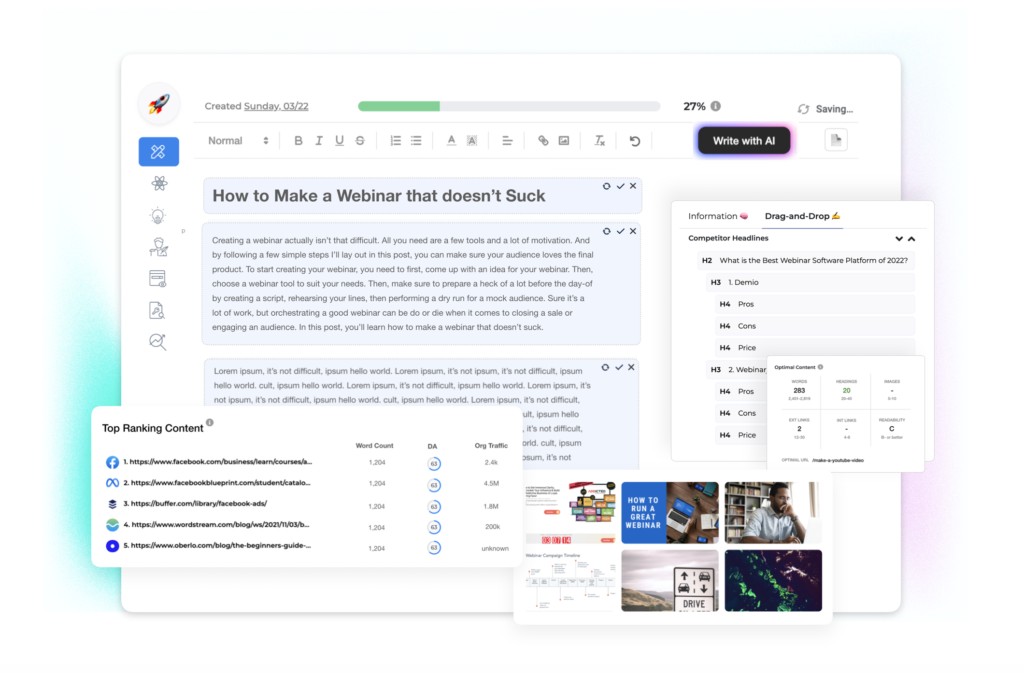
Part 3: How to write SEO content that dominates Google
Ok, so you’ve planned your content. Great!
Whether you’re creating blog posts or product pages, you need to follow some best practices to make sure your pages and posts rank.
1. Craft great headlines
Your headline is the first impression your content will make even before a person lands on your web page. When they do land on your page, your headline is what makes the person decides to stick around or leave your site to check TikTok or Instagram.
Strong headlines aren’t just important for search engines and readers, but they can also lead to more social shares.
A study even shows that the majority of social shares that articles get come from people who have not even read the article (a little scary, I know). Instead, most share the content based on the headline alone. Follow these simple tips to craft compelling headlines:
- Be specific
- Use numbers
- Use brackets
1. Be specific
Your headlines need to be specific, they should tell your prospect exactly what they will get. For example, look at these two headlines:
“Save Enough Time The Easy Way”
“Save 3 Hours Per Day With 5 Productivity Hacks”
The first headline is not horrible, however, is also not nearly specific. Look at the second headline, it’s much better and supper-specific. This rule applies to blog posts, website copy, landing pages, and other forms of content.
2. Use numbers
Numbers force you to write specific headlines that improve your clickthrough rate. Use the current year in your headline, this makes it:
- Stand out in organic search results and
- Quickly communicate to readers that this guide is up-to-date for them.
3. Use brackets
Including a portion of the headline in (brackets) also tends to make it pop visually on a search engine results page.
A joint study by OutBrain and Hubspot found that adding brackets to headlines can improve CTR by up to 38%.
Finally, try your best to use your target keyword or keyphrase in your headline. Both Google and readers like to see this, as it confirms that the article does indeed address the query.
2. Craft a compelling introduction
When I write an article, I spend more time on the introduction than any other section.
That’s because bounce rate and dwell time are such important SEO metrics. If people don’t like what they read and bounce right away, Google will have no choice but to move you down in the SERP.
If you hope to keep readers on your blog post, you’ve got to make a strong first impression with a compelling intro. Here are some introduction tips:
- Start with a good hook
- Use transition words
Start With A Good Hook
Starting with a good hook clearly explains to the reader what they can expect. A great hook or the opening sentence is important to draw people in, a great hook could be:
- A quote
- A startling statistic
- A short anecdote
- A question
- An interesting fact
- A controversial statement
- Or You could use drama or humor, etc.
I like to use the problem-agitate-solution (PAS) framework. This means, first you need to highlight the problem for the reader (“If you don’t have enough leads it’s impossible to scale your business”). Then, explain what they’re probably going through if they have that problem (“if you don’t have enough leads, you’ll never be able to raise that next round of funding or hit profitability”). Finally, solve the problem (“but with GrowthBar, you’ll be able to attract more leads, faster, using long-form content written by AI”).
Use The Transition Method
This is most important at the end of your introduction. Transitions help push people to read the next section. You always want to hook readers and give them a reason to keep going.
Transition words or phrases include:
- Let’s dive right in
- Let’s get started
- Let’s jump right in
- Without further ado, let’s begin, etc.
Do your best to tease information at the end of the introduction so that the user must stay on page or risk missing out on great information!
3. Write Your Content
Now you need to write the body of your content and make it super engaging to your prospects. Here are a few tips to do that:
- Use subheaders: That’s because subheaders break your content up into easy-to-read chunks.
- Use lists, bullets, and bolded sentences: Once you have your post organized, you can then start adding decorations: lists, bullets, bolded sentences, italics, etc. All of these make your content easy to read, particularly on mobile phones (which is 58% of web traffic).
- Use active voice: You should always write in the active voice. It tends to be easier to read and understand, and evokes more action.
- Use large enough fonts: Do you notice Medium is easy to read? They use a 21px font. If you’re using anything less than 15px, you may be losing lots of readers.
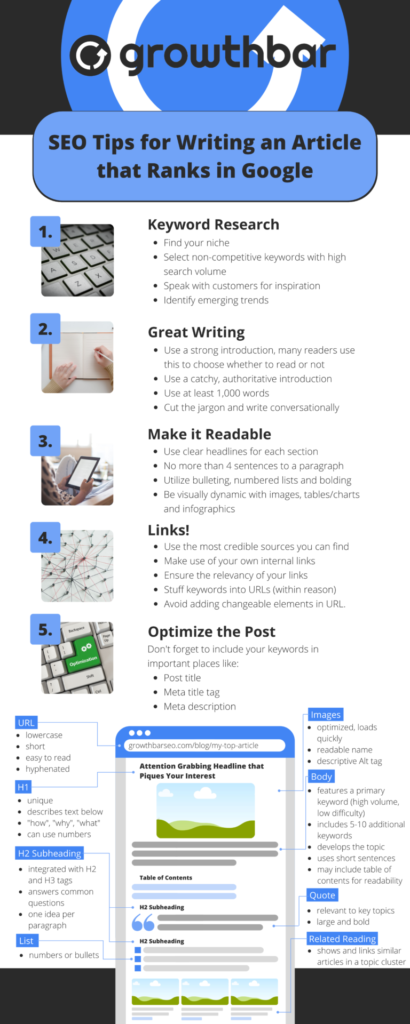
4. Add a conclusion
Your conclusion is essential, especially if you want people to comment or take some action at the end of your post.
You can make a summary of your content in the concluding section, this is the most frequently used tactic in blog posts. A summary is great because some of your readers may likely have forgotten a lot of the points you made throughout the piece. Plus, they’re not difficult to write.
You can also include a call to action (CTA) in the concluding section. The standard way to conclude your article is to incorporate a specific CTA. After all, what good is SEO if it doesn’t drive some revenue to your business? You can ask your readers to:
- Comment
- Share your content on social media
- Sign up for your email or newsletter
- Demo your product
- Or offer them more content
Make your CTA relevant to the article and actionable.
Also read: 6 Steps for Writing an Article that Ranks on Google
Part 4: Optimize your content for search engines
Now that you know your content is ready, it’s time to optimize it for search engines. In this section, I’ll show you how to optimize every piece of content on your website.
1. Permalinks/URLs
URLs also called “permalinks” are like an address but for pages on the internet. Use a short and descriptive URL slug, this helps people immediately understand what the page is about before even visiting them.
Most content management systems (CMS) let you change the URL slug or permalink (the part after the domain and subfolders) easily and using your target keyword or related terms is often the simplest and the best way to optimize your content. Do this for nearly all your blog posts.
For example, the WordPress Gutenberg editor lets you do this effortlessly:
Go to the right-hand side panel when writing or editing your post and click on setting, then post.
Go to permalinks:
You can edit your URL or permalink here. Follow these best practices when editing your permalinks:
- Avoid using numbers in your permalinks
- Keep it short and sweet
- You use related queries when setting your URLs
- Avoid changing your URLs in the feature
2. Title tags/SEO titles
Your title tag, also known as the SEO title (if you are using WordPress and the Yoast SEO plugin) is your page title but it only appears on search results pages. It is crucial to have a captivating tag, this improves your clickthrough rates.
WordPress will default your post title as your SEO title or title tag. While the default isn’t always bad, you can and should optimize it if it’s not SEO-friendly.
Most platforms enable you to change your SEO title. For instance, in WordPress, you can use Yoast to change the title tag by navigating to the bottom of your page or post:
In the box above, you can simply change your title tag. Here are some of the best tips to use when crafting your title tag or SEO title:
- Use more than one keyword in the title. Notice I write “What is A URL (Permalink Meaning)”? This gives your article the chance to rank for both keywords.
- Avoid lengthy title tags. Even though you can use more than one keyword, that doesn’t mean you should craft longer titles. Google will truncate lengthy title tags leading to poor clickthrough rates.
In the image above, the title tag is longer than the limit so Google truncates it.
3. Heading tags
Headline tags break your content into H1, H2s, H3s, H4s, H5, H6s, and so on. Headlines are used to arrange your content in order of importance, with the H1 title tag being the most important of all.
WordPress defaults your post title to H1, so you can move on with H2s, H3s, H4s, and so on. The best practice is to have some similarities between your SEO title and your H1 title.
Headlines are used both by search engines and your audience. Use headlines to break up your content and make it more skimmable for readers.
Add your target keyword in your H1 tag and spread related queries of your target keyword throughout the rest of the headline tags.
Tips for writing Headlines:
- Frontloading your keywords: place the keyword as close to the beginning of your headline as possible)
- Avoid keyword stuffing (but you can include related phrases)
- Use headline modifiers like “best”, “easy”, “guide”, “checklist”, “free”, etc. This improves your click-through rates.
4. Meta descriptions
The meta description is your page’s summary and appears on the search engine results page (SERPs).
The meta description is an HTML code that’s meant to briefly summarize your page or post, and search engines often use this right within the search.
- Meta descriptions aren’t used as ranking signals, but it helps users learn more about your page.
- It gives users a glimpse of your entire content.
- It also influences clickthrough rates, and for that reason, it’s a good practice to add it to your pages.
- Google states that it’s a good practice to add meta descriptions to your pages.
You can use tools like GrowthBar’s Meta Generator to generate meta descriptions that are already working out there.
To generate a meta description for your content, navigate to the Meta Generator in the GrowthBar toolbar to describe your keyword, and hit submit.
Next, check out the results:
And there you have it, you can click the “create more” button for more ideas.
5. Optimize your images
Optimized images can rank in Google images and add to your traffic growth. Particularly in industries with a lot of image search, like e-commerce or real estate, optimizing your images is a huge on-page SEO win.
Optimizing your images for SEO is done in 3 ways:
- Name your image files appropriately
- Use alt text
- Compress images
Name your image files appropriately
This is done by using the name of the item in your image. Most cameras use generic names for pictures, for example, if you take a picture of a cat with your phone it may be something like “IMG_ and then several numbers”. The best practice is to rename it as “cat”.
According to Google, filenames can give Google clues about the subject matter of the image.
Use descriptive alt text
Alt text, short for “alternative text” is an HTML attribute that goes into your image tag so the syntax would look something like this:
<img src=“https:// your domain name.com/cat.jpg” alt=” cat”> cat sitting on a couch.”
Where the alt value should describe the image. “Alt text” helps improve accessibility for those who are using screen readers or if the image fails to load, visitors will be shown the alt text instead.
In WordPress, you can use related keywords to describe your images as “alt texts”. I use the GrowthBar Keyword Research tool to get awesome related keywords for my images.
Simply enter your keyword in the keyword research tool and hit submit.
Then scroll to related queries at the bottom.
From the results above, you have several phrases that can be used to describe your images “alt text”, phrases like:
- “How to write SEO-friendly blog post”
- “How to write an optimized SEO blog post”
- “How to write a good blog post for SEO”
You can use these related keyphrases to describe your images in WordPress.
Compress Your Images
Compressing images makes your image file sizes smaller, leading to faster load times. And PageSpeed is a Google ranking signal.
There’s a free tool for compressing images called “ShortPixel” which has both a web interface as well as a WordPress Plugin.
6. Add internal links
Internal links are links from one page on the same domain to another. And they’re super-powerful because they can pass link authority to other relevant pages, and they also help search engines better understand a page’s contents.
For instance, if you had a site in the careers niche, and you are writing a post about “how to write a cover letter”, then you’d want to add internal links from other relevant pages like “how to write a resume”.
More importantly, visitors who want to learn “how to write a resume” would probably want to know how to write a cover letter and vice versa. So they help users navigate your site.
Internal links keep visitors on your site longer, which is a great signal to Google.
Also read: The Ultimate Guide to Internal Linking
7. Optimize for mobile friendliness
Mobile-friendliness describes how your site performs on mobile devices. A mobile-friendly website is important because more than 50% of search traffic comes from mobile devices.
If people on smartphones and tablets aren’t comfortable on your site, your ranking and search traffic will decrease. You can check your site here!
Google uses mobile-friendliness as a ranking factor, this means if your site isn’t optimized for mobile users, you’re losing valuable leads and revenue.
8. Optimize your page speed
Search engines like Google use page speed as a ranking factor. That’s because a slow page isn’t a good experience for Google users.
Page Speed measures how fast content on your pages can load.
A 5.2 million website analysis from Backlinko shows you can improve site speed by moving to a faster host. You can use the Google PageSpeed Insights tool to check how your site is performing.
This site scores 83% on mobile, it still needs improvement. You can check your site speed for both mobile and desktop.
The easiest ways to improve page speed are:
- Choose a reputable website builder like WordPress, Shopify, etc.
- Use a reputable web host or switch to a host with faster speeds
- Use a content delivery network (CDN) like Cloudflare to dynamically serve up images
- Use plugins like “lazy load” to reduce the initial page load weight on the server
Site speed and other elements of technical SEO are very important for on-page SEO. However, don’t overdo it. Even the biggest and best sites in the world have technical and speed issues.
Part 5: Optimize your content for readability
On-page SEO optimization is two folds: search engines and users or readers. Here are some tips to optimize for readability.
- Don’t overcrowd your content
- Push content above the fold
- Avoid using big words
1. Don’t overcrowd your content
If you need people to read and drive value from your content and become loyal customers then you should do one thing: don’t overcrowd your content. For example,
Instead, make your posts easy to read by sticking to paragraphs that are 1-2 sentences long.
Short paragraphs are easier to read, especially on mobile devices.
2. Push content above the fold
When someone lands on your page, they need answers to their query fast.
You need to give them what they need above the fold.
A lot of people miss the mark here. Use these tips to avoid pushing content below the fold:
- Feature your blog post images after the first 100-200 words
- Avoid bigger images
- Have your H1 tags front and center of the page
- Have proof points (press badges or social proof) above the fold, if relevant
3. Avoid using big words
People must understand your content. Craft your sentences like you’re speaking, this makes your content more conversational and entertaining to read.
Free tools like Grammarly or Hemingway will help in the process if you’re having trouble.
Google wants to offer its users content that gives them everything they want on a single page, which means “comprehensive and easy to understand”.
Part 6: On-page SEO tools
Oh… yes!
SEO is all about using tools to optimize your content and make it stand the chance of ranking higher on Google, and the tools out there aren’t cheaper that’s why this section is included. There are a lot of tools out there that can help improve your on-page SEO. Here are some of the best:
1. Google LightHouse Audit
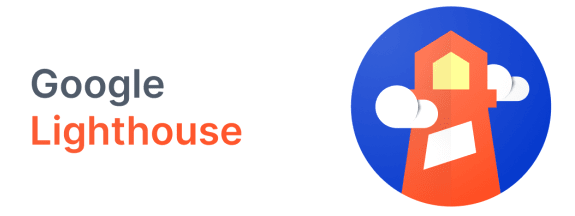
Features: Good news: Google LightHouse Audit is free. If you’ve never used it before, stop what you’re doing and try it now. This free, open-source software is available to everyone. Google LightHouse Audit is a Google-created tool for auditing your site for performance, accessibility, SEO, and best practices. Combined, all those things cover a lot of what the Google Algorithm cares about. Plus, it was created by Google. “Straight from the horse’s mouth” as they say.
There are four ways to use Lighthouse:
1) in Chrome DevTools, for pages requiring authorization
2) automated, from the command line, via shell scripts
3) as an integrated Node module
4) from a web UI without installing anything
The easiest way to access Google LightHouse is in Chrome DevTools Tools. Simply open a webpage in a Chrome browser. Right click on the page and click “inspect.” This will open DevTools. Then select “Lighthouse” and “Generate report.”

Give it a few minutes and voila!
Google will surface a whole bunch of key metrics in an easy-to-understand interface.
It even prints a step-by-step roadmap for fixing your site

I like it because it’s fast and free.
For: As a free, open-source software, this tool can be used by just about anyone!
Price: Free, no matter which method you use.
2. Screaming Frog
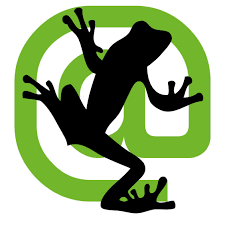
Features: Screaming Frog is one of the best known technical audit tools out there. Known industry-wide for developing their groundbreaking SEO spider tool, Screaming Frog also has a complete lineup of SEO management software, including link building, Pay Per Click (PPC), content and social media marketing, analytics and Conversion Rate Optimization (CRO).
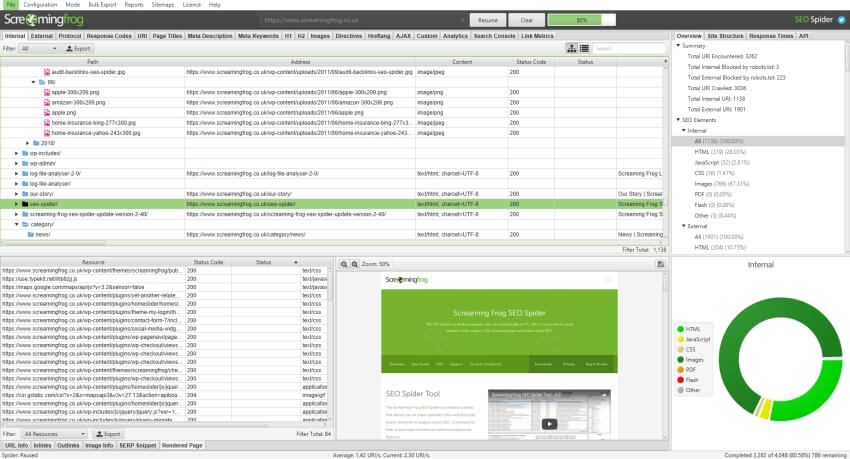
Screaming Frog’s core audit tool crawls websites, much like a spider. It takes snapshots of each page as it crawls, and then uses those snapshots to create a visual representation of a website. This representation includes a list of all broken links, in order of how many times they were found. It is also capable of generating a sitemap, finding duplicate content, and scanning for malware.
The Spider SEO Crawler allows you to audit up to 500 URLs for free, but upgrading to a premium plan removes that limit as well as opens access to extra features. Sift through page titles and metadata, zero in on duplicate content, extract site data, even generate XML site maps with ease. Integrate your favorite tools like Google Analytics and PageSpeed Insights with API integration, and get in-deep with bot programming directives.
Screaming Frog also has a Log File Analyzer.
The Log File Analyzer provides intuitive insight into SEO efficacy with log file upload, bot verification and data analysis and crawled URL reporting – both identification and frequency. Screaming Frog enables you to discover errors and broken links that are holding back your SERP performance, locate temporary and permanent redirects, and highlight load times to isolate large and slow pages.
For: Small-medium size businesses
Price: Many features are available for analysis of up to 500 URLs free, but many more advanced features are available, for unlimited URLs, starting at $149.00 per year.
3. GrowthBar

Features: GrowthBar is a suite of tools made for content SEOs. That means if you’re a blogger or part of a marketing team executing an SEO strategy, GrowthBar may be the tool for you.
GrowthBar has a number of features, but it really excels in content auditing. Simply enter a query and input your blog post. GrowthBar will surface all elements of the blog post that might be holding it back, including word count, headline count, image count, external links, internal links, readability, NLP keywords and more.
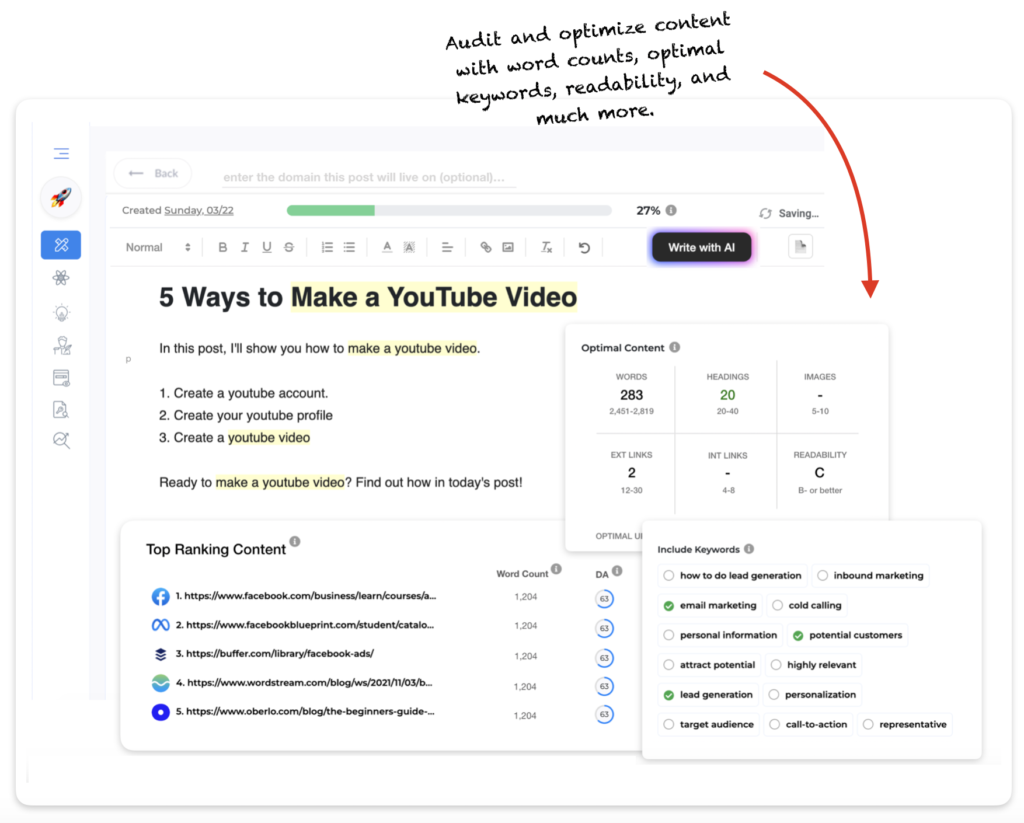
GrowthBar operates using correlational SEO, which means that GrowthBar scrapes the top posts in the Google search engine results page and determines which elements are the most important for ranking. GrowthBar’s intelligent algorithms weight different factors in the SERP and deliver a delightful dashboard and roadmap for improving your blog post.
For: Bloggers, agencies, and content teams
Price: Try all the features free for 5 days, then plans start at $29/mo and include premium bonus features like keyword research, backlink research, and other AI content generation functions.
Also read: The 11+ Best SEO Audit Tools (Including On-Page Audits)
Part 7: Advanced on-page SEO optimization
Here are some of the more advanced on-page SEO optimizations and tips to pay attention to.
1. Programmatic SEO
Programmatic SEO is one of my favorite disciplines of SEO. Essentially, the goal is to make lots and lots of webpages without much manual labor. There are tools and strategies for accomplishing this, but the process remains the same as normal content creation and on-page SEO.
First, research keywords, with a keen eye for keywords that scale — meaning there are hundreds of thousands or millions of searches per month for long-tail keywords. Many of them are related to geo-local searches. Examples include:
- The best handyman in every city (Angi (formerly Angie’s List))
- The best coworking spaces in every city (CoworkingReviews.com)
- The best therapists in every city (BetterHelp)
- Travel reviews of every city and activity (Tripadvisor)
But they don’t have to be geo-related. Additional examples include:
- Software reviews (G2)
- How to connect this app to that app (Zapier)
- Company employee reviews (Glassdoor)
The point is this: find a vertical with programmatic opportunity, then hire VAs or employ a web scraper to find as much information as possible. Assemble this content with the help of a programmatic SEO tool or no-code app builder.
Programmatic SEO is the holy grail of on-page SEO.
2. Outputs vs inputs
When it comes to blogging there are tons of interesting things that you can look at and waste your time on Google analytics, traffic views, affiliate income, and ad revenue.
But if you focus too much on the outputs and not the actual work or the inputs you’re never going to find success.
So all in all, it’s about a lot of “content and links” “content and links” “content and links”.
These are the inputs you need to focus on to get to monetization but sometimes you want to make money right away, you want to join Adsense too soon, you want to do all of those things.
When you first start a blog and it’s like maybe three or four months old and it isn’t getting much traffic yet. You’re driving to work in the morning and you’re checking Google Analytics on your phone, and see like “oh I got nine visitors today.”
That’s cool. I’s slowly getting higher and higher but you can get bogged down in this data forever if you’re not careful.
You can focus so much on all this data that you’re just not working on the business.
So first of all, you need to make sure that you’re working on the business by focusing on the inputs which are: get down and start writing content or building links. Those are the two things you need to be doing.
You need to either be:
- In front of an article writing it
- Writing a brief for a writer if you’re outsourcing or
- Making LinkedIn messages and
- Emails for link building
So those are the things you need to do, you need to focus on the inputs of your business, actually running your content-driven business, and not just focusing on the outputs and things you expect to happen.
Conclusion
In summary, on-page SEO isn’t difficult, but it’s definitely essential. It’s where much of the work in SEO goes and it’s where most of the low-hanging fruit can be grabbed.
Remember to plan and write content according to SEO best practices. Quality > quantity. If you need some extra help, grab an on-page tool like GrowthBar or any of Google’s free audits.
Finally, remember that off-page SEO and on-page SEO work hand in hand. So you need to do both if you need to rank higher in Google for your target keywords.
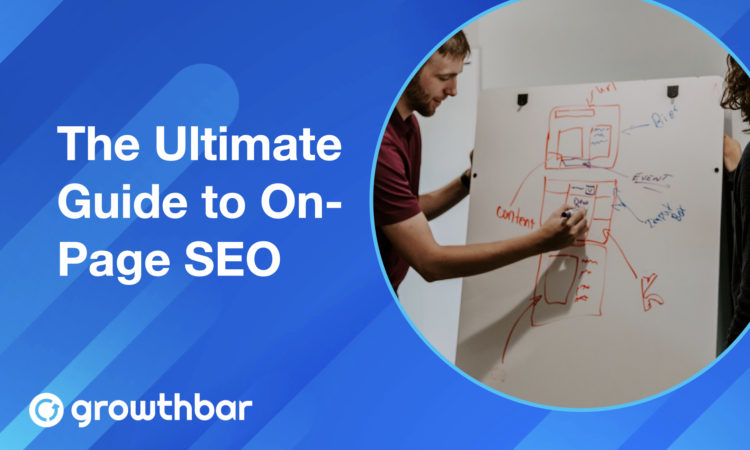
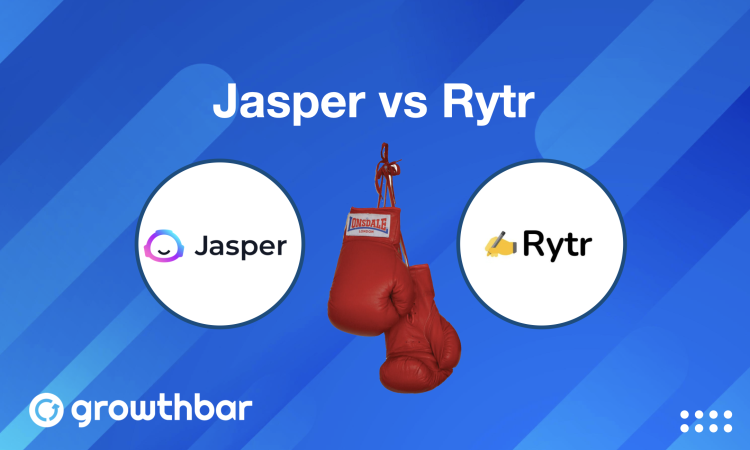

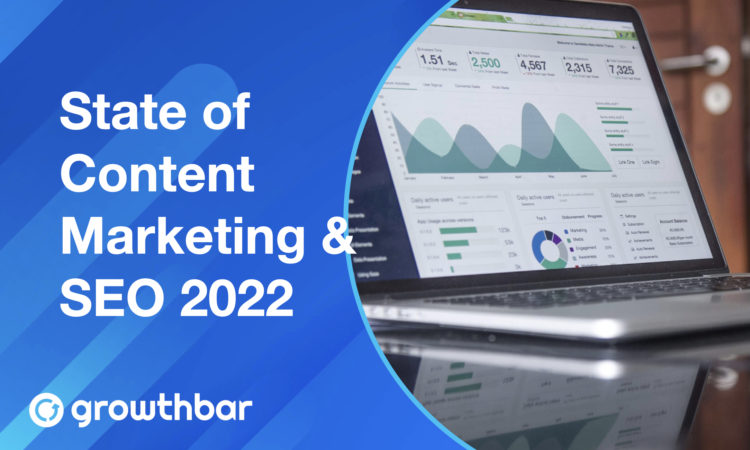
Abdul-Wakil
Hi Hailey Friedman, thanks for your awesome article on on-page SEO. I like your style of writing and the GrowthBar tool. Keep providing us with digital marketing tips.